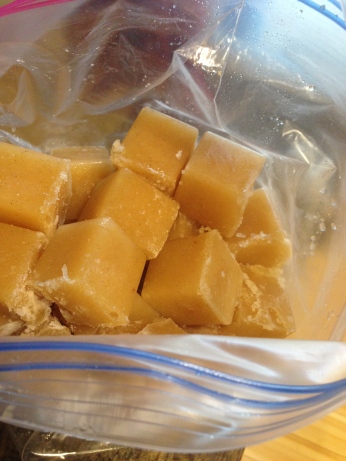Making your own baby food is not nearly so fussy as it sounds. If you have a well-equipped kitchen, it requires no special equipment. Why would anyone go to the trouble? 1. It’s cheap. 2. I like the idea of using organic produce for the littlest of eaters. I’d prefer to keep pesticides at bay at least for a little while. 3. It’s fresh and it tastes infinitely better. Infinitely. The jarred stuff is pretty gross. Even the purees in the pouches lose a fair amount of flavor in the process of pasteurization. Not that I’m anti-pasteurization. Louie Pasteur did our society a tremendous service (with pasteurization and vaccines!). Pretty incredible, really. It’s a good thing when storing food over months/years. However, those high temps can leave flavorful fruits and veggies tasting a bit, well, sterile.
 So I make my own. I promise though that I’m not a snob. We use some store-bought stuff on occasion, and I certainly don’t judge if you don’t take the time to lovingly hand-craft your precious little angel’s every bite. Really. We eat box mac & cheese in my house too.
So I make my own. I promise though that I’m not a snob. We use some store-bought stuff on occasion, and I certainly don’t judge if you don’t take the time to lovingly hand-craft your precious little angel’s every bite. Really. We eat box mac & cheese in my house too.
If you’re so inclined to make baby food, a few basic pieces of equipment are necessary to get started.
1. A food processor or blender

2. Ice cube trays
Really, that’s pretty much it. The best ice cube trays for making baby food would be the nice silicone variety. Several sets of trays are nice to have on hand if you’re planning to make lots of food at once. Upon making giant batches of food, spread the puree into your trays, freeze. Pop out the cubes and you’re good to go.
 If you’re willing to go the extra mile with baby food-making, there are a few other tools that can be nice.
If you’re willing to go the extra mile with baby food-making, there are a few other tools that can be nice.
3. little containers in which to transport said food. I like these and these.
4. this contraption & these pouches
These pouches are incredibly handy to have when you’re traveling. They’re a bit of a luxury, but the lack of need for a spoon means no mess to clean up. They freeze well and can be thawed in a bit of warm water (or overnight in the fridge). The little filling station is an absolute must if you plan to go this route. These things would be nearly impossible to fill without it. With it, the filling process is a breeze. 
The real reason I make my own baby food is that it allows me to be a bit more creative with what the baby is eating. I enjoy that. The first purees that I make for baby are always single-ingredient and very simple, but after the basics are covered, baby food combos have become incredible little bombs of flavor. Carrot-apple-mango. Roasted banana-blueberry. Sweet peas-green beans-mint. Apricot-golden beet. Raspberry-vanilla bean-pear. Avocado-pineapple.
The other advantage here is that your homemade purees can contain the flavors you want in the ratio you want. It’s not the tiniest amount of raspberry with applesauce filler.
The first purees that you feed your baby should be simple. One ingredient, just to make sure that your baby does not have a reaction. Rice cereal has been a commonly recommended first food by physicians, though it’s not always necessary to start there. First foods are probably going to wind up in your hair rather than in the baby’s stomach anyway. Maybe those beets aren’t the best idea. Really though, you just want an ingredient that you can puree until it’s completely smooth.
first purees
steamed carrots
Wash and peel as many carrots as you feel like making. (I typically make about 2 pounds at once. That is more than enough carrots to get through the entire carrot-eating stage.) Steam using a steamer pan or in the microwave with a small amount of water in the bottom of the bowl until carrots are easily pierced with a fork. Puree in a food processor or blender until very, very smooth. Spread into ice cube trays and freeze.
sweet potato
Pierce sweet potatoes several times with a fork. (I make about 7 giant spuds at once. This puree also serves as the base of some amazing pancakes.) Roast at 450°F until potatoes are fully cooked. Scoop the flesh into the bowl of a food processor. Blitz until smooth. Freeze in ice cube trays
vanilla bean pear
Peel ripe pears. (I typically make 7-8 at once. After the baby is used to a bit of texture, I leave the skins on.) Remove cores. Place pears in a Dutch oven. Add water about halfway up the side of the pot. Add seeds from 1-2 vanilla bean pods. Cook over medium heat, stirring occasionally, until pears are tender. Puree until smooth. Freeze in ice cube trays.
parsnip
Wash and peel parsnips. Steam until tender. Puree until smooth and freeze.
other ideas for single ingredient purees
avocado
steamed asparagus
applesauce
peach
beet
butternut squash
mango




